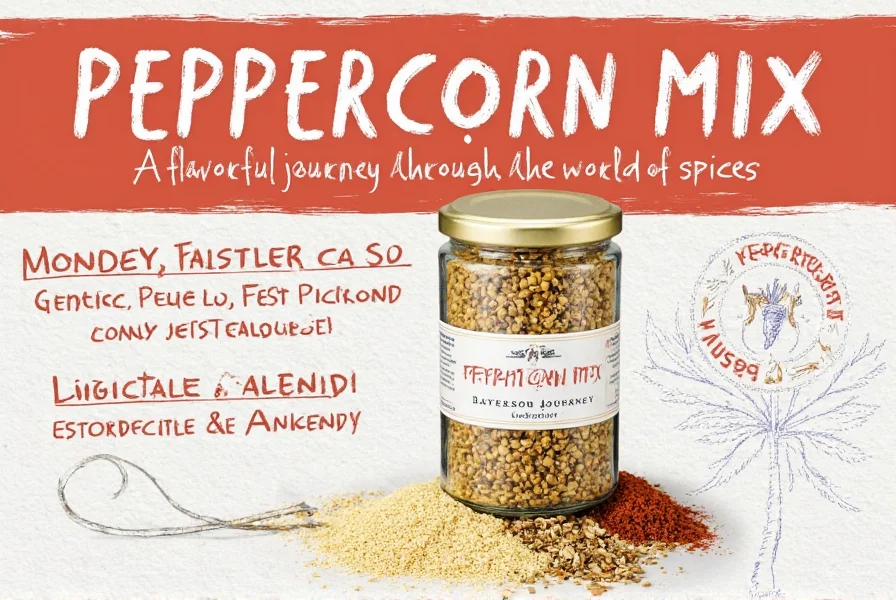Peppercorn mix is a versatile blend of different colored peppercorns (black, white, green, red, and pink) that adds complex flavor to dishes. Unlike single-variety pepper, a mix combines the distinctive characteristics of each type for a more nuanced seasoning experience. Whether you're cooking steak, seafood, or desserts, understanding peppercorn mix can elevate your dishes. This guide covers everything you need to know: types, how to use, buying tips, storage advice, and answers to common questions.
Table of Contents
Types of Peppercorns and Their Flavors
There are several types of peppercorns, each with its own unique flavor profile. Here's a quick breakdown of the most common ones:
| Type | Flavor Profile | Best For |
|---|---|---|
| Black Pepper | Pungent, sharp, and slightly sweet | Steak, meats, soups, and stews |
| White Pepper | Milder, earthy, and slightly sweet | Creamy sauces, light meats, and mashed potatoes |
| Green Pepper | Fresh, grassy, and citrusy | Seafood, salads, and Asian dishes |
| Red Pepper | Spicy, fruity, and slightly sweet | Curries, spicy dishes, and marinades |
| Pink Pepper | Fruity, floral, and slightly peppery | Desserts, salads, and gourmet dishes |

How to Use a Peppercorn Mix in Cooking
A well-crafted peppercorn mix can add layers of flavor to your meals. Here are some tips on how to use it effectively:
- Seasoning: Sprinkle a pinch of peppercorn mix over grilled meats, roasted vegetables, or steamed fish for a burst of flavor.
- Marinades: Add a tablespoon of peppercorn mix to your favorite marinade for enhanced taste and aroma.
- Condiments: Mix it into sauces, dressings, or dips to give them an extra kick.
- Finishing Touch: Sprinkle it on top of soups, stews, or pasta dishes before serving for a final flavor boost.

Buying Guide for the Perfect Peppercorn Mix
When purchasing a peppercorn mix, there are several factors to consider to ensure you get the best quality and flavor. Here's a detailed buying guide:
Key Features to Look For
- Quality: Choose a mix made from fresh, high-quality peppercorns without any artificial additives.
- Balance: The mix should have a harmonious blend of different pepper types, not dominated by one variety.
- Origin: Consider where the peppercorns are sourced, as this can affect the flavor and quality.
- Storage: Ensure the product is packaged in airtight containers to preserve freshness.
Recommended Products
Here are a few popular peppercorn mixes that are highly recommended:
- Harvest & Co. Black & White Pepper Blend: A classic mix that offers a balanced combination of black and white pepper, ideal for steak au poivre and everyday cooking.
- Spice Hunter Red & Green Pepper Mix: A vibrant blend that adds both heat and freshness to dishes, perfect for seafood and Asian cuisine.
- Pepper & Spice Pink Pepper Infusion: A unique mix that adds a floral note to salads and desserts, great for gourmet cooking.
Frequently Asked Questions
What exactly is peppercorn mix?
Peppercorn mix is a blend of different colored peppercorns (typically black, white, green, and sometimes red or pink) that creates a complex flavor profile. Unlike single-variety pepper, a mix combines the distinctive characteristics of each peppercorn type to deliver a more nuanced seasoning experience. The different peppercorns are actually from the same plant (Piper nigrum) but harvested at different stages of ripeness, with the exception of pink peppercorns which come from a different plant family altogether.
What's the difference between the various colored peppercorns?
The color difference comes from how and when the peppercorns are harvested and processed. Black peppercorns are harvested unripe and sun-dried, creating their characteristic pungency. White peppercorns are fully ripe berries with the outer layer removed, resulting in a milder flavor. Green peppercorns are unripe berries preserved in brine or freeze-dried to maintain their fresh, grassy flavor. Red peppercorns are fully ripe berries that are more delicate and sweet. Pink peppercorns, while not true peppercorns, add a floral, fruity note to blends.
How should I store my peppercorn mix to maintain freshness?
Store your peppercorn mix in an airtight container away from heat, light, and moisture. A dark cupboard or pantry is ideal. Whole peppercorns can stay fresh for 1-2 years when stored properly, while pre-ground pepper loses potency much faster (3-6 months). For maximum flavor, buy whole peppercorns and grind them as needed rather than purchasing pre-ground mixes.
Can I make my own custom peppercorn mix at home?
Absolutely! Making your own blend allows you to customize the flavor profile to your preferences. A classic starting ratio is 2 parts black pepper, 1 part white pepper, and 1 part green pepper. For more adventurous mixes, add pink peppercorns (use sparingly as they're milder) or even include other spices like coriander or allspice berries. Store your homemade mix in an airtight container and use within 6 months for best flavor.
What dishes work best with peppercorn mix?
Peppercorn mix shines in many applications: steak au poivre (classic pepper-crusted steak), creamy sauces where white pepper's subtlety works well, seafood dishes enhanced by green peppercorns' freshness, and even in some dessert applications where pink peppercorns add floral notes. It's versatile enough for soups, stews, roasted vegetables, and salad dressings. The key is to match the intensity of your mix with the dish - more delicate preparations work better with lighter blends.
Should I buy pre-ground peppercorn mix or grind my own?
For the best flavor, always grind whole peppercorns just before use. Pre-ground pepper loses its volatile oils and aromatic compounds quickly, resulting in diminished flavor. Invest in a good quality pepper mill that can handle the different hardness levels of various peppercorns (black and white are hardest, green and pink are softer). If convenience is essential, look for mixes that come in resealable containers with freshness indicators.
Is there a difference between Tellicherry and regular black peppercorns?
Yes, Tellicherry peppercorns are a specific grade of black pepper named after the region in India where they're grown. They're larger, more mature berries that are harvested at peak ripeness, resulting in a more complex, nuanced flavor with fruity and floral notes compared to regular black peppercorns. In a peppercorn mix, Tellicherry black pepper can add superior depth and should be considered for premium blends.
Are pink peppercorns safe to eat?
Yes, but with some caveats. True pink peppercorns come from the Schinus molle or Schinus terebinthifolius trees (not Piper nigrum). While generally safe for most people in culinary amounts, they can cause allergic reactions in individuals sensitive to plants in the cashew family. Unlike black, white, and green peppercorns, pink peppercorns are more delicate and should be added toward the end of cooking to preserve their subtle flavor.
Pro Tips for Using Peppercorn Mix
Here are some practical tips to make the most out of your peppercorn mix:
- Grind Fresh: For the best flavor, grind your peppercorns just before using them.
- Experiment: Don't be afraid to mix and match different peppercorns to create your own unique blend.
- Pair Wisely: Some peppercorns pair better with certain foods—experiment to find your favorites.
- Store Properly: Keep your peppercorn mix in a cool, dark place to maintain its potency and freshness.
Conclusion
In conclusion, a peppercorn mix is more than just a spice—it's a flavorful journey that can transform your cooking. By understanding the different types of peppercorns, how to use them, and what to look for when buying, you can unlock new dimensions of taste in your kitchen. Whether you're a professional chef or an amateur enthusiast, mastering the art of peppercorn mix is a rewarding endeavor. So go ahead, experiment, and let your palate explore the world of spices!










 浙公网安备
33010002000092号
浙公网安备
33010002000092号 浙B2-20120091-4
浙B2-20120091-4